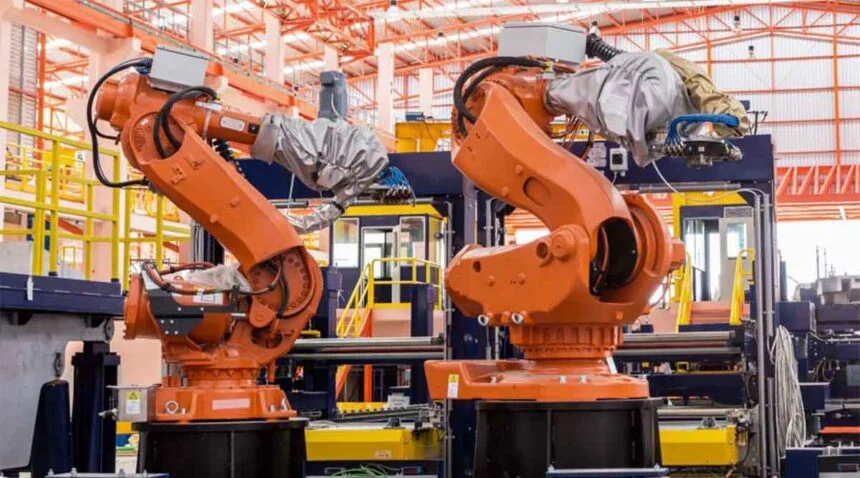Collaborative robots, often called “cobots,” are transforming modern manufacturing by introducing a flexible, human-friendly approach to automation. Unlike traditional industrial robots that work in isolation for safety, cobots are designed to work alongside human employees, helping to streamline tasks and improve output. Their adoption is driven by the need for higher efficiency, greater precision, and cost savings in an increasingly competitive industrial landscape. This article explores how cobots contribute to productivity and efficiency, their practical applications, their impacts on workforce dynamics, and the future of cobots in manufacturing.
Introduction to Collaborative Robots (Cobots)
A collaborative robot, or “cobot,” is a type of robot specifically designed to work safely alongside human operators. Unlike traditional industrial robots, which are typically isolated due to their size, speed, and power, cobots are equipped with sensors, lightweight materials, and advanced programming to ensure safe interactions in shared workspaces. This design enables cobots to assist human workers without posing significant safety risks, creating a new paradigm in manufacturing that emphasises partnership rather than replacement.
As industries face increasing demands for productivity and efficiency, cobots are gaining momentum as a practical solution. Their ability to perform repetitive and precise tasks while adapting to various roles makes them invaluable in a rapidly evolving industrial landscape. The benefits of cobots are vast, from enhancing output and quality to providing the flexibility needed for modern production lines.
How Cobots Drive Productivity in Manufacturing
One of the standout benefits of cobots is their ability to work harmoniously with human employees, thereby enhancing overall productivity. Human-robot collaboration allows for the best of both worlds: the adaptability and decision-making skills of humans, combined with the speed, precision, and endurance of robots. Cobots are designed to handle repetitive or physically demanding tasks, which can alleviate fatigue for human workers and reduce errors.
The precision cobots bring to manufacturing is invaluable. When performing tasks that require high accuracy, such as assembly, welding, or quality inspection, cobots consistently deliver superior results. By minimising errors, manufacturers can reduce waste and rework costs, improving product quality and maximising efficiency. Additionally, since cobots do not require breaks or shift changes, they can operate around the clock, increasing production capacity without the need for extensive overtime or multiple human shifts.
Improving Efficiency with Cobots
Efficiency in manufacturing is more than just increasing output; it involves optimising workflows, reducing resource waste, and achieving consistency in product quality. Cobots play a crucial role in streamlining manufacturing processes by minimising bottlenecks and ensuring seamless task transitions. For example, cobots can perform material handling duties, transporting parts between stations and freeing human workers to focus on more critical tasks that require problem-solving skills.
Consistency is another area where cobots excel. When tasked with repetitive jobs, cobots can deliver uniform quality, helping to maintain high standards across production lines. This is especially important for industries like electronics or automotive manufacturing, where even slight deviations can lead to significant quality issues.
Applications of Cobots in Manufacturing
Cobots have found applications in various stages of the manufacturing process, from assembly to inspection. In assembly, cobots handle tasks that require both precision and speed, such as placing small components or fastening parts with accuracy. Their assistance in these repetitive tasks not only improves assembly speed but also reduces the strain on human workers, who may find such tasks monotonous or physically demanding.
Material handling is another area where cobots excel. They can move materials or finished products from one part of the production floor to another, eliminating the need for humans to perform these physically taxing tasks. This helps to enhance worker safety while maintaining a steady workflow. Cobots are also instrumental in quality control and inspection. Equipped with sensors and cameras, cobots can detect product defects with a higher degree of accuracy than human inspectors, ensuring that only high-quality products move forward in the supply chain.
Impact of Cobots on Workforce and Skill Development
The integration of cobots into manufacturing does not signify a reduction in human labour; rather, it provides new opportunities for skill development and job enrichment. As cobots take over repetitive and physically strenuous tasks, they enable human workers to engage in roles that require critical thinking, decision-making, and supervisory skills. Employees are often required to learn new skills, such as programming and maintaining cobots, which can enhance their career prospects.
Reskilling and upskilling initiatives are essential as companies introduce cobots into their operations. Workers who were once focused on manual tasks may now need training in robotics, programming, and maintenance. This shift not only benefits employees by expanding their skill sets but also helps companies build a more versatile and technically capable workforce.
Conclusion
Cobots represent a transformative force in manufacturing, providing a range of benefits that include improved productivity, greater efficiency, and enhanced product quality. By working alongside human workers, cobots help to optimise manufacturing workflows, reduce errors, and maintain consistency across production lines. Beyond the immediate benefits, cobots also offer long-term advantages, such as creating new opportunities for employee skill development and contributing to a safer, more fulfilling work environment.



